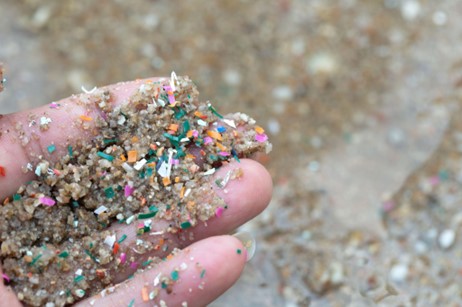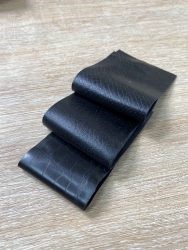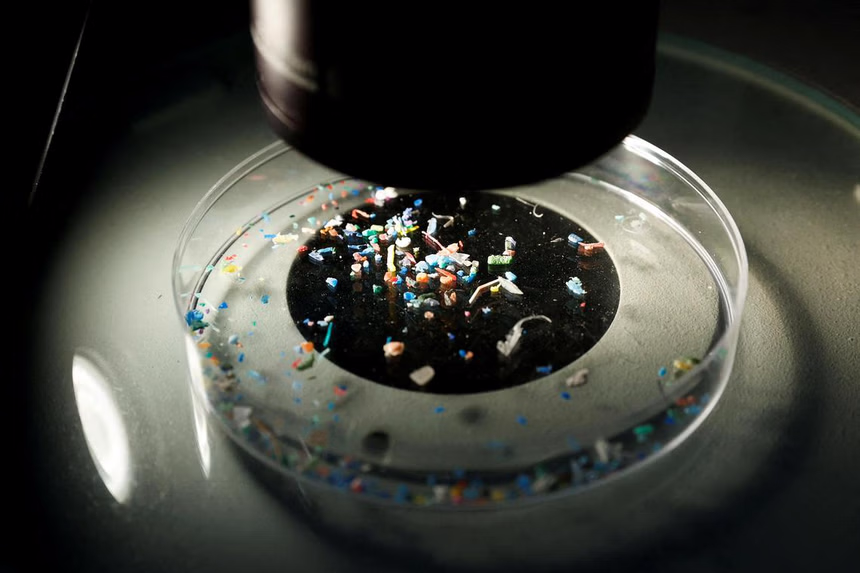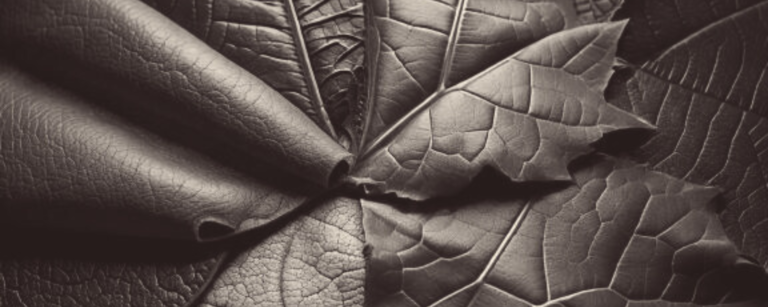Microplastics in Textiles: The Hidden Pollution of Synthetic Materials
In the North Pacific, a massive plastic accumulation spanning over 1.6 million square kilometers has formed what is often called the “7th Continent.” While other garbage vortexes exist in oceans worldwide, this one is the largest, containing 80,000 tonnes of debris and microplastics. The root cause of this ecological disaster? Pollutants from land—and one of the main culprits is the clothing we wear. According to studies, microplastics from textiles account for over one-third of oceanic plastic pollution. But where do these tiny particles come from? Why are they so prevalent in synthetic fabrics, especially faux leather? And what dangers do they pose to the environment? Let’s explore these pressing questions.
What Are Microplastics?
Plastic is a widely known material, often derived from petroleum. It is made by combining synthetic polymers (man-made molecules that do not exist naturally) with additives like plasticizers and dyes. Common types of plastic include:
- PET (Polyethylene Terephthalate): Found in bottles and disposable packaging.
- LDPE (Low-Density Polyethylene): Used in plastic bags and food wrap.
- PS (Polystyrene): Found in yogurt pots and pens.
Microplastics are tiny fragments of plastic ranging from a few hundred nanometers to five millimeters in size. They can be classified as:
- Secondary Microplastics: Resulting from the breakdown of larger objects (e.g., plastic bags, fishing nets) due to sunlight, weather, or prolonged immersion.
- Primary Microplastics: Released directly into the environment in their original form, such as tire dust, microbeads in cosmetics, and—most significantly—fibers shed during the washing of synthetic textiles.
Faux Leather: A Polluting Alternative to Real Leather
Over one-third of primary microplastic emissions originate from synthetic textiles, including materials like polyester, acrylic, and nylon—all petroleum-based fibers. Faux leather, often marketed as an ethical or sustainable alternative to animal leather, is another significant contributor to microplastic pollution.
What Is Faux Leather?
Faux leather, whose name may raise questions, can refers to artificial materials designed to mimic the properties, appearance, and uses of real leather. However, it is not leather and does not contain animal products. Common types of faux leather include:
- PU (Polyurethane): A plastic-based material created by coating textiles like cotton, nylon, or polyester with polyurethane.
- PVC (Polyvinyl Chloride): A cheaper but more harmful option, often softened with phthalates to make it flexible.
Where Is Faux Leather Used?
Faux leather is prevalent in:
- Clothing, shoes, and accessories (e.g., hats, belts).
- Bags and wallets.
- Furniture (e.g., chairs, sofas).
- Automotive interiors (e.g., seat and steering wheel covers).
These materials degrade over time, releasing microplastic particles that contaminate ecosystems, especially marine environments.

The Environmental Impact of Textile Microplastics
The “7th Continent”: A Plastic Soup
Microplastics, measuring just a few nanometers to five millimeters, are up to 70 times smaller than a human hair. After being shed during laundry cycles, they bypass wastewater treatment plants, enter sewage systems, and eventually flow into rivers and oceans. A 2023 study by five NGOs revealed that a single washing machine cycle can release millions of plastic particles into nature.
Charles Moore, the explorer who discovered the first garbage patch in 1997, described the scene:
“Day after day, I saw no dolphins, no whales, no fish—only plastic.”
These garbage patches, or gyres, are formed by ocean currents and the Earth’s rotation. They act as vortexes that accumulate debris from the surface to depths of 30 meters. Microplastics exacerbate this pollution, with 80% originating from land-based sources.
Toxic Effects on Marine Ecosystems
An estimated 30 million tonnes of plastic enter oceans annually, and the number of microplastic particles has increased 100-fold over the past 40 years. Marine organisms, including 386 fish species studied by WWF, are ingesting these particles, leading to:
- Intoxication and Poisoning: Microplastics absorb heavy metals, phthalates, and pesticides, releasing these toxins as they degrade.
Physical Harm: Ingestion causes intestinal blockages, suffocation, and death. Greenpeace estimates that one million birds and 100,000 marine mammals die from plastic pollution each year.
Ecosystem Imbalance: Microplastics enable invasive species, such as the water spider Halobates sericeus, to thrive, disrupting marine food chains.
A Sustainable, Plastic-Free Solution: Phyli® by La Tannerie Végétale
Addressing the issue of textile microplastics requires systemic change. This includes rethinking synthetic clothing consumption and embracing truly sustainable materials.
Why Phyli® Stands Out
After seven years of research and over 1500 tests, La Tannerie Végétale has developed Phyli®, a revolutionary alternative to leather that is:
- 100% Plant-Based: Free from plastic.
- Biodegradable and Recyclable: Leaves no lasting environmental footprint.
- Low Carbon and Water-Free: Produced with minimal environmental impact.
- Made in France: Supporting local industries.
- Cruelty-Free: No animal products involved.
- High-Quality and Durable: Designed for luxury markets.

Unlike other plant-based leather alternatives that may still contain plastic or require high carbon emissions, Phyli® offers a genuinely sustainable and ethical solution.
Key Takeaways
- What are microplastics? Tiny plastic particles, often derived from petroleum, measuring up to five millimeters.
- Where do microplastics come from? Found in everyday items like plastic bags, packaging, and synthetic textiles.
- Are microplastics in clothing? Yes, synthetic fabrics like polyester, nylon, and faux leather are major sources.
- What are the dangers of microplastics? They pollute ecosystems, harm marine life, and disrupt biodiversity.
- How can we combat textile pollution? By reducing synthetic clothing consumption and adopting sustainable materials like PHyli®.
La Tannerie Végétale is proud to lead the way with Phyli®, proving that luxury, ethics, and sustainability can go hand in hand.
👉 Want to learn more about Phyli®? Contact us or subscribe to our updates.
References
- Moore, C. (1997). Discovery of the Great Pacific Garbage Patch. Retrieved from Marine Research Organization.
- Greenpeace. (2023). Impact of Plastic Pollution on Marine Wildlife. Available at Greenpeace Reports.
- WWF. (2023). Microplastic Ingestion in Marine Species. Accessed from WWF Research.
- La Tannerie Végétale. (2024). PHyli®: A Sustainable Alternative to Leather. Visit La Tannerie Végétale.


